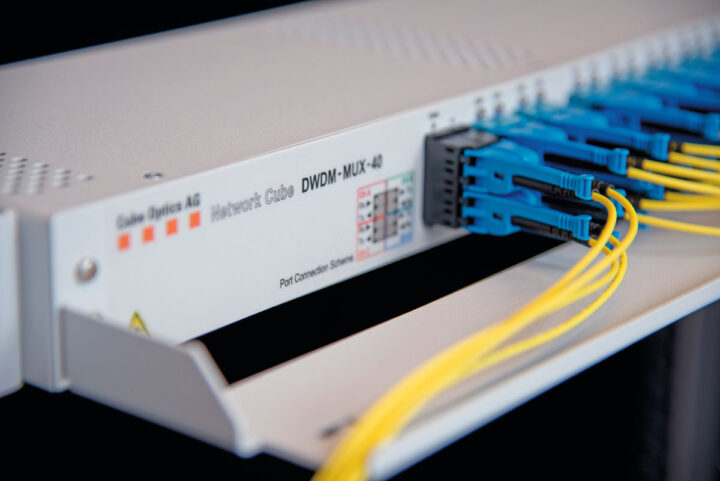
Thanks to the wide range of HUBER+SUHNER Cube Optics products, we are able to build a cost-effective solution for 100 Gigabit Ethernet transport.
The complex challenges of designing a 100 Gigabit network
Passive transport networks based on 10 Gigabit Ethernet (10GE) are relatively easy to design and operate. Using passive wave multiplexing and transceivers tuned to CWDM/DWDM band wavelengths, we can easily and efficiently build point-to-point networks up to 80 km. Transceivers are commonly available for all possible types of active devices, scaling up to 40 or 80 channels using a single pair of optical fibers thanks to DWDM multiplexers.
But what is the situation when moving to 100 Gigabit Ethernet (100GE)? Very flexible use is offered by active DWDM elements with transponders for converting black and white signals (wavelengths of 1310 nm) to colour (wavelengths in the DWDM spectrum of 1550 nm). The main disadvantage of this solution is the purchase price. Not every application requires such a robust solution.
Even in the world of stogig networks, the passive solution known from 10GE can be used. However, it has its pitfalls. Basically, it can be solved in three ways:
- Solutions with LR-4 transceivers
- Direct Detect method
- Coherent 100GE
We just need one 100GE circuit
Solutions with LR-4 transceivers
Order a pair of 100GBASE-LR4 transceivers from us, plug them against each other on unlit fiber, and if your active elements are no more than 10 km apart, congratulations. Everything will work right out of the box!
For this scenario to be realistic, we need to realize:
- We need to have an unlit thread dedicated to this one circuit only
- Maximum range of LR4 transceiver is 10 km
Fortunately, the range of this transceiver can be extended by using a solid-state preamplifier (SOA). We also have it available as a 1U stand-alone unit. The real range of a conventional transceiver in combination with an SOA amplifier is 50 km.
SOA amplifier, stand-alone 1U chassis
LR-4 transceivers operate in the most common 1310 nm band, which is also the band our SOA amplifier can operate in. Other wavelengths are blocked.
In the following example, we will show how to effectively use e.g. 40-channel MUX, which is equipped with a port for 1310 nm in addition to DWDM channels.
In the upper part of the figure we can see how 40 10GE circuits are connected to the DWDM channels. An amplified signal from the 100GBASE-LR4 transceiver is connected to the 1310 nm port. Suddenly, we can run existing 10GE circuits and one 100GE circuit side by side with a single pair of unlit fiber. In this configuration, we can effectively use 0.5 Terabit/s bandwidth.
Parallel operation of multiple 100GE
Direct Detect method
Direct Detect are transceivers that use four lasers at wavelengths in the DWDM band. The resulting link consists of four 28Gbit/s signals each travelling over a different pair of optical fibres. The transceiver thus has four pairs of LC connectors on it.
Transceiver direct detect CFP
This configuration allows us to split the 100Gbit/s signal into four DWDM channels and transmit it through a conventional Multipexor. Channels on the transceiver can be tuned to 50GHz DWDM grid in C-band according to ITU-T.
For these transceivers, we are again talking about a signal range of around 15 km. However, just add an EDFA amplifier, dispersion compensation and a 96 channel waveform multiplexer and you have a working solution with a transmission capacity of 2.4 Tbit/s up to 60 km.
100GE for long-haul
Transceiver with coherent detection
The coherent approach to 100GE is particularly popular in long-distance applications – for example, submarine cables or routes hundreds of kilometres long. In access and metropolitan networks, they are usually not used because of the economic intensity of this technology. Compared to the direct detection method, it is 3 to 4 times more expensive.
The advantage is that the optoelectric conversion process is linear, allowing direct electrical compensation for linear fiber effects including chromatic and polarization dispersion. The dispersion therefore does not need to be compensated externally, it is done directly in the transceiver. Another advantage is that we only need one DWDM channel to transmit a coherent 100G signal.
The disadvantage of the solution is not only the purchase price but also the high energy consumption (85W). Transceivers are then typically not available as plug-in modules.
Conclusion
As a partner of HUBER+SUHNER Cube Optics we have a wide product portfolio that includes wavefront muliplexers, transceivers, amplifiers, DCM modules (dispersion compensation), but also active elements with transponders, ROADMs, muxponders or RAMAN amplifiers.
This enables us to provide you with the entire transmission system and take responsibility for the recovery and configuration of complex transport solutions. If 100GE is a topic for your network please do not hesitate to contact us.